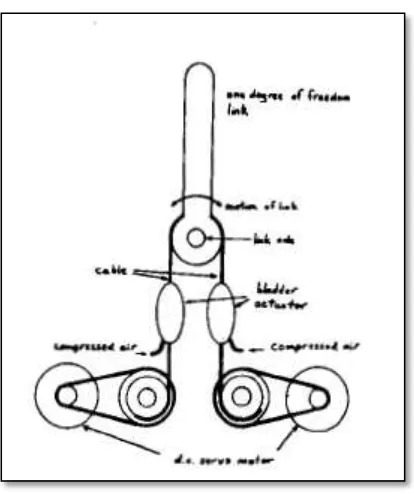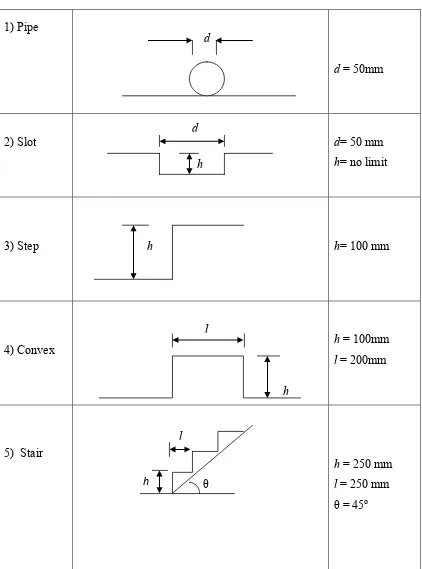EXPLORING AND DESIGNING ACTUATOR FOR NEONATAL BABY’S LEG SIMULATOR
NURUL FARIHAH BT MUSA
This Report Is Submitted In Partial Fulfillment of Requirements For The Bachelor Degree in Electronic Engineering (Industrial Electronic)
Fakulti Kejuruteraan Elektronik dan Kejuruteraan Komputer Universiti Teknikal Malaysia Melaka
JUNE 2015
v
vi
1
ACKNOWLEDGEMENT
First of all, many thanks to Almighty God for giving me the strength and motivation to finish the task that given to me. I like to thank my parent for the support, understanding and encouragement to fulfil my task of completing the PSM and this thesis. I also would like to sincerely thank my supervisor, En. Sani Irwan Bin Md Salim, for his guidance and support throughout and especially for his confidence. Forgive me if there is wrong doing that I have done in the time you supervising me. I also indebted to Universiti Teknikal Malaysia Melaka (UTeM) library for the assist on supplying the knowledge and relevant research to accomplish my project. To all my friends, thank you for the support, understanding, motivation and encouragement in the way of accomplishing this project. Thank for giving the ideas and borrowing any equipment that was used to complete the project. Your friendship makes my life wonderful. Lastly, I like to thank all people that contribute directly or indirectly to accomplish my project. My God bless you all for the help given
vii
ABSTRACT
viii
ABSTRAK
3
ix
2.2 Hybrid Actuator for Robot Manipulators: Design,
Control and Performance. 5 2.3 Design and Control of a Manipulator Arm Driven by
Pneumatic Muscle Actuators 6
2.4 Improvement of Operation Speed for The legged
x
2.5 Design and Control of a Two-Wheel Self-Balancing Robot
using the Arduino Microcontroller Board. 9
2.6 Measurement and Modelling of McKibben Pneumatic
Artificial Muscles. 10
2.7 Comparison Between Literature Review 11
2.8 Comparisons between Arduino UNO, PIC 18F4550 and
xi
4.5 Control Signal 35
4.5.1 Output Voltage of Servo Motor 36
4.6 Discussion 38
V CONCLUSIONS
5.1 Conclusions 41
5.2 Recommendation 42
REFERENCES 43
APPENDIX A 45
APPENDIX B 46
APPENDIX C 47
xii
LIST OF TABLE
NO TITLE PAGE
Table 2.4.1 Five Types of Floor 8
Table 2.7 Comparison between Literature Review 11
Table 2.8 Comparisons between Arduino UNO, PIC 18F4550
and Raspberry Pi. 13
Table 4.5.1.1 The Table of Sine Waves, With An Amplitude Of 10 37
xiii
Figure 2.9.2 Board layout of Arduino motoDuino 15
Figure 2.10.1 Analog Motor Servo 16
Figure 2.10.2 The duration of the pulse the angle of the output shaft 17 Figure 2.10.3 Typical speed-torque characteristics of mechanical loads 18 Figure 2.10.4 Typical speed-power characteristics of mechanical loads 19
Figure 3.2.1 Overall project Flowchart 21
Figure 3.2.2 Block Diagram of the Process 22
Figure 3.4.1 Position A: Both baby leg’s are horizontal to 90 degrees 23 Figure 3.4.2 Position B: Both baby leg’s are vertical to 60 degrees. 23 Figure 3.4.3 Position C: Right leg baby is vertical 60 degrees while the left leg baby is 90 degrees. 23 Figure 3.4.4 Position D: Left baby leg’s moving to 60 degrees while the right baby leg’s is down to 90 degrees. 24 Figure 3.4.5 Position E: Both baby leg’s moving 24 Figure 3.5.1 Compression and tension spring at rest and under load 25
Figure 3.6.1.1 Micro servo SG91R 26
Figure 3.6.2.1 ATmega328P Microcontroller 27
Figure 3.6.2.2 The Microcontroller Block Diagram 27
xiv
Figure 3.7.2 The Arduino IDE 30
Figure 3.8.1 Project Gantt chart 31
Figure 4.2.1.1 The tools in project 33
Figure 4.2.2.1 The Prospect after cutting 33
Figure 4.5.2 The Complete Structure of Baby’s leg 36
Figure 4.5.1.1 The Output Voltage Of The Servo Motor From
The Oscilloscope 36
Figure 4.5.1.2 Voltage Vs Time curve 38
1
CHAPTER I
INTRODUCTION
1.1 Introduction
This section discusses the overall project, including project background, problem statement, project objectives and scope of the project.
1.2 Background
A newborn baby’s first movements may appear jerky and random. However, usually the newborn baby moves in a pattern or rhythm. For example, if the newborn baby is active and alert, the baby will tend to start moving her arms and legs, then slow down and stop, and repeat the process after a second or minute. Some newborn babies move more or less frequently than others. They may move in rhythm with their mother’s voice.
2
different types of problems associated with prematurity. Even when everything is “normal”, prematurity itself has many challenges.Additionally, premature babies are somewhat more fragile than term babies. Though is not usually a problem, a premature birth exposes the baby to more injury sources, including possibly the birth itself. Premature babies have small size and light weight. A newborn baby’s will move his legs and his hands first. If the baby was moving actively, the movement his hands and legs will be more aggressive and will sometimes slowly and sometimes stop. Then he would repeat it after one or two minutes. Muscle baby is one factor in the development of motor skills baby premature. The normal babies have normal muscle. With arm and legs tucked into the body, premature baby able to keep his movement in a nice flexible position.
3
1.3 Problem Statement
The current implementation of the manikin is huge and the accuracy of movement is far from the real experiences. For that, need actuators which fit into the very small space inside the body. These actuators need to generate the leg movements. For this leg, power consumption, size and so on is major issues.
1.4 Objective of the project
The aim of this project:
1. To study the neonate’s baby’s movement, especially the legs. 2. To design an actuator for baby’s leg, movement simulator.
3. To analyze leg muscle in term of movement, power consumption and size.
1.5 Project Scope
The scopes of the software are as follows.
i. Write and control program is based on the programming language C.
. The scope of the hardware is as follows:
i. Arduino MotoDUINO used in this project as the main medium in driving two servo motors with an Arduino board and control the motor speed.
4
CHAPTER II
LITERATURE REVIEW
2.1 Introduction
Background research projects have been carried out before the start of the project with information about the movements of the neonate's especially baby’s leg. Among the things that should be emphasized is the type of technology, methodology and methods of control used. This chapter will discuss and review available literature on.
5
2.2 Hybrid Actuator for Robot Manipulators: Design, Control and Performance.
This journal purposes a new method used two available actuation technologies, DC servo motors and polymer bladder type actuators. Through a suitable control applied to the hybrid actuator, independent control of joint torsional stiffness, and joint position is made possible. DC servo motors are used to cover for muscle actuator length changes; hence the joint position is not affected. The computed torque technique has been implemented with the hybrid actuator in place, utilizing high gain feedback on the servo motors, to achieve the stated goals. However, the currently is underway to formulate control strategies that do not depend so heavily on knowledge of the subsystem dynamic parameters. [1]
Figure 2.2.1: Proposed hybrid actuator
6
2.3 Design and Control of a Manipulator Arm Driven by Pneumatic Muscle Actuators.
This journal used the pneumatic artificial muscles (PAMs) as are methodical in the experiment. Figure 2.3.1 shows the operating principle of PAM. Pneumatic systems are very commonly used in industrial robotics because their power to weight ratio and simplicity. Pneumatic muscle is able to pulling actuator operated by gas pressure. Powered by compressed gas, artificial muscle actuator contracts lengthwise when expands and convert the radically expansive force into axial being contracted force. Various types of pneumatic actuators used in industrial environment are cylinders, pneumatic motors, pneumatic stepper motors and bellows. The problem statement in this paper is problems connected to the accuracy of control and the nonlinearities of pneumatic systems have prevented their widespread use in high precise servo systems and advanced robotic systems. For the experiment results have shown good in dynamic performances of the closed loop system, but steady-state error might not satisfy some advanced controlled systems. In order to get better positional accuracy, some advanced control approaches can be used. Pneumatic artificial muscles are undoubtedly very suitable actuators for new types of industrial robots. [2]
Figure 2.3.1: Operating principle of PAM.
7
2.4 Improvement of Operation Speed for The legged Robot With Wheels by Intelligent Motion Control.
Build a robot that can move worthy of using wheels and should move in a stable on the floor who doesn’t mind using the wheeled legs. The creeping movement is more excellent compared with walking at the point of simplicity and stability of gait. But to build the robot using a creeping movement, the speed of the robot is slow. Moreover, by subtracting the weight of the robot can power-up of the actuator can increase the movement of the robot. Therefore, maximum torque, efficient usage of actuator and velocity changes need to be recorded. They proposed to improvement torque ratio, so;
Trat
Tmax : Motor maximum torque [Nm]
9
2.5 Design and Control of a Two-Wheel Self-Balancing Robot using the Arduino Microcontroller Board.
Arduino is open-source with a large user community and up-to-date discussion forums. This allows students to study other users’ codes, compare results, and make modifications according to the project’s needs. Arduino boards are low-cost and expandable, where optional peripherals called shields can be purchased as and when needed. The Figure 2.5.1 shows the balancing robot and this journal reviewing a student project about the design, construction robot and control two-wheeled self-balancing robot. The Robot uses two DC motors and Arduino ATmega 2560, proportional-integral-differential (PID) and linear-quadratic regulator (LQR) as control design. LQR control can be implemented as a PI-PD controller and the PID control is chosen because it is easy to learn and implement, for which text book design methods are available. Motor selection for the balancing robot emphasizes torque output instead of velocity, because it has to oppose the rotational moment that gravity applies to the robot. Hence, the motors need to provide enough torque to correct the robot’s body pose back to a balanced state. In the result, the design has been successfully done to offset the self robot using low cost components. The PID control is chosen because it is easy to learn and implement, for which textbooks design methods are available. [4]
10
2.6 Measurement and Modelling of McKibben Pneumatic Artificial Muscles.
This journal reviewing about the McKibben artificial muscle. It is developed in the 1950’s, but was too complicated to control until the 1990’s. McKibben muscles are an actuator which converts pneumatic (or hydraulic) energy into mechanical form by transferring the pressure applied to the inner surface of its bladder into the shortening tension. The Figure 2.6.1 shows the model of McKibben muscle. Energy efficiency is most important in driving energy efficiency. So, some simulation in describing the high efficiency can be introduced. According to thermodynamics, mechanical energy is transformed into gas internal energy or heat when a gas is compressed, and gas internal energy or heat is transformed back to mechanical energy when gas is expanded (except a free expansion). Besides that,the actuator can produce positive net mechanical work if it shortens at higher pressure under larger tension and lengthens at lower pressure under smaller tension (if the tension in shortening and in lengthening is the same, there will be no network produced). However, the actual energy efficiency of the actuator will be lower due to additional non ideal energy losses. For the conclusion, the pneumatic system, which provides control and power to the actuator, still needs a lot of improvement. [5]


